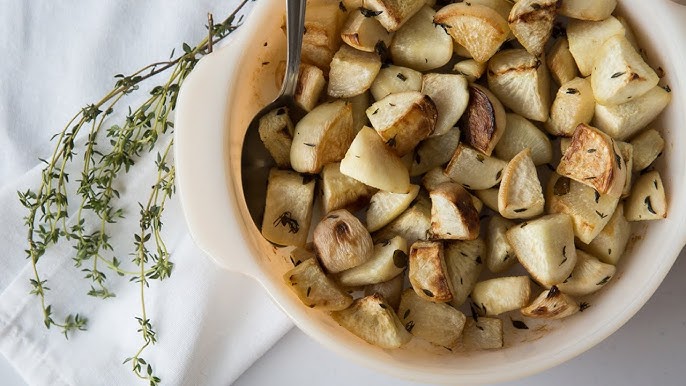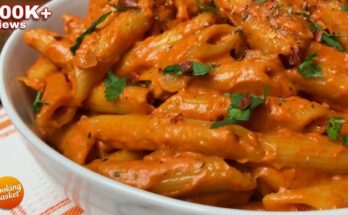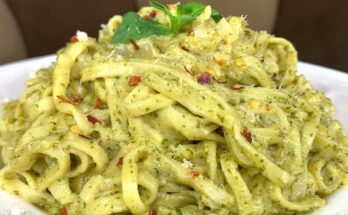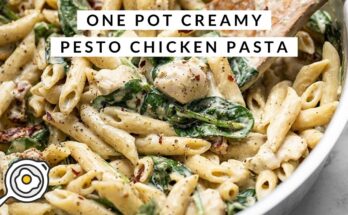Turnips Recipe: Turnips often fly under the radar when it comes to root vegetables, but they’re seriously underrated. This humble veggie can be turned into a creamy mash, roasted for a crispy side dish, or even incorporated into soups and stews. The best part? They’re nutritious, budget-friendly, and surprisingly versatile. Whether you’re a kitchen pro or a beginner, this comprehensive step-by-step guide will walk you through creating the perfect turnip dish—loaded with flavor, texture, and nourishment.
Let’s start with the basics before diving into the step-by-step cooking process.
What Are Turnips?
Turnips are round root vegetables that belong to the Brassicaceae family, which also includes cabbage, broccoli, and Brussels sprouts. Typically white with a purple top, turnips have a mildly peppery flavor when raw and a slightly sweet, earthy taste when cooked. They’re in season mainly in fall and winter, making them a staple in cozy, comfort-food recipes.
Smaller, younger turnips tend to be sweeter and more tender, while older ones can be tougher and a bit bitter. Turnip greens—the leafy tops—are also edible and packed with nutrients. So, when you’re buying turnips, consider getting the whole bunch to make the most of every part.
Health Benefits of Turnips
Besides their great taste and texture, turnips come loaded with health perks. They’re low in calories, high in fiber, and full of vitamin C. This makes them excellent for boosting immunity, improving digestion, and supporting skin health.
Turnips are also a good source of:
- Potassium, which helps regulate blood pressure.
- Calcium, essential for bone health.
- Antioxidants like glucosinolates, which may help prevent certain cancers.
Adding turnips to your weekly menu is a smart move if you’re looking to eat clean and maintain a balanced diet.
Why Cook with Turnips?
Turnips are like the underdog of the kitchen—they don’t get the spotlight, but they should. Here’s why:
- Affordable: A great veggie that won’t break your grocery budget.
- Versatile: Boil, mash, roast, fry—you name it.
- Easy to Store: They last for weeks in the fridge.
- Nutritious: Full of essential nutrients and fiber.
Plus, they soak up flavors beautifully. Whether you’re going for garlic, herbs, butter, or spices—turnips will deliver.
List of Ingredients You’ll Need
Before we jump into the kitchen, let’s make sure you’ve got everything ready.
Basic Ingredients for Classic Turnip Recipe
For a simple and delicious turnip side dish, you’ll need:
- Fresh turnips (about 2 lbs) – peeled and chopped.
- Olive oil or butter (2–3 tablespoons) – for roasting or sautéing.
- Salt (to taste) – enhances the flavor.
- Pepper (to taste) – adds a little kick.
- Garlic (2–3 cloves, minced) – optional but highly recommended.
- Fresh herbs (like thyme or rosemary) – for added aroma and taste.
These basics are all you need to create a classic turnip dish that’s warm, savory, and satisfying.
Optional Add-Ins for Flavor Enhancement
If you want to level up your turnip game, consider adding the following:
- Grated Parmesan cheese – adds umami and richness.
- Heavy cream or sour cream – great for mashing turnips.
- Onions or leeks – sautéed with turnips for a mellow, sweet flavor.
- Chili flakes or paprika – for some heat.
- Maple syrup or honey – a touch of sweetness balances bitterness.
Feel free to experiment with what you have in your pantry. Turnips play nicely with most flavor profiles.
Ingredient Substitutions You Can Try
Missing something? No worries. Try these substitutions:
- Butter → Olive oil (healthier option).
- Garlic → Garlic powder (if you’re in a pinch).
- Fresh herbs → Dried herbs (just reduce quantity by half).
- Turnips → Rutabaga or parsnips (if you want to try a twist).
Being flexible with ingredients is the key to stress-free cooking—and it keeps things fun in the kitchen.
Kitchen Tools and Equipment
Before cooking, let’s round up the right tools. Using the proper equipment makes prepping and cooking a breeze.
Essential Tools for Cooking Turnips
Here’s what you’ll need:
- Cutting board – for clean and safe chopping.
- Sharp chef’s knife – makes peeling and cutting easy.
- Vegetable peeler – helpful for larger or older turnips.
- Mixing bowl – for tossing turnips with oil and seasoning.
- Baking sheet or skillet – depending on the method (roasting vs. sautéing).
- Pot or saucepan – if you’re boiling or making mashed turnips.
- Colander – for draining boiled turnips.
These tools are likely already in your kitchen. Just lay them out before starting.
Prep Tips to Save Time and Effort
- Pre-peel and chop: Turnips can be prepped up to 2 days ahead and stored in the fridge.
- Use parchment paper: When roasting, it prevents sticking and makes cleanup a breeze.
- Double up: Make a bigger batch and repurpose leftovers in soups or stir-fries.
A little prep goes a long way in making your turnip recipe both quick and enjoyable.
Step-by-Step Guide to Cooking Turnips
Step 1: Wash and Peel the Turnips
Rinse the turnips thoroughly under cold water to remove dirt. Use a vegetable peeler or paring knife to remove the outer skin, which can be tough and slightly bitter.
Step 2: Chop into Desired Size
Cut the turnips into uniform cubes or slices, depending on how you plan to cook them. Smaller pieces cook faster and absorb flavor better.
Step 3: Choose Your Cooking Method (Boil, Roast, or Mash)
- Boil: Simmer in salted water for 15–20 minutes until tender.
- Roast: Toss with oil and bake at 400°F (200°C) for 25–30 minutes until golden.
- Mash: Boil, then mash with butter or cream.
Step 4: Seasoning and Flavoring Tips
Add butter, garlic, salt, pepper, or fresh herbs like thyme for flavor.
Step 5: Final Cooking and Serving Suggestions
Serve turnips as a side dish, mix with carrots or potatoes, or puree them for a creamy, earthy mash—simple, hearty, and delicious!
Different Ways to Cook Turnips
Not sure how you want to serve your turnips yet? Let’s dive into some popular recipe styles that bring out the best in this versatile vegetable.
Roasted Turnips
Roasting is perhaps the most flavorful method. It transforms the mildly bitter root into a golden, caramelized bite that’s crispy on the outside and soft on the inside.
Basic Roasted Turnips Recipe:
- Preheat oven to 425°F.
- Peel and cube 2 lbs of turnips.
- Toss with 2 tbsp olive oil, salt, pepper, and herbs (thyme works great).
- Spread evenly on a baking sheet.
- Roast for 25–30 minutes, flipping halfway through.
Pro Tip: Add carrots, parsnips, or sweet potatoes for a colorful roasted veggie medley.
The edges get beautifully browned, and the inside turns soft and sweet. This dish is an excellent side for anything grilled or roasted.
Mashed Turnips
Creamy and comforting, mashed turnips are a perfect low-carb replacement for mashed potatoes. They’re slightly lighter and have a subtle, nutty flavor.
Mashed Turnips Recipe:
- Boil peeled and chopped turnips for 10–15 minutes until fork-tender.
- Drain thoroughly to avoid watery mash.
- Add 2 tbsp butter, 1/4 cup cream or milk, salt, and pepper.
- Mash to desired consistency.
- Add garlic or Parmesan for extra flavor.
Serve alongside roasted meats or as a bed for stews and gravies.
Turnip Stir-Fry
If you’re in a hurry and craving something savory and fast, a turnip stir-fry is your go-to. This dish is quick to make, packed with flavor, and ideal for weeknight dinners.
Turnip Stir-Fry Recipe:
- Peel and julienne 2–3 turnips.
- Heat 1–2 tablespoons of sesame or vegetable oil in a wok or skillet.
- Add sliced onions, garlic, and ginger. Sauté for 1–2 minutes.
- Toss in the turnips and stir-fry for 5–7 minutes until slightly golden and tender.
- Add soy sauce, a pinch of sugar, and chili flakes for a little heat.
- Optional: Add bell peppers, carrots, or bok choy for extra color and crunch.
Pro Tip: Serve over jasmine rice or noodles and garnish with sesame seeds and green onions.
This stir-fry is light yet flavorful and makes a great vegetarian or vegan main dish.
Turnip Soup or Stew
Turnips bring a unique depth of flavor to soups and stews. They’re hearty, absorb the richness of broths, and hold up well during long simmering.
Simple Turnip Soup Recipe:
- Sauté onions, garlic, and celery in a large pot.
- Add chopped turnips and cook for 5 minutes.
- Pour in vegetable or chicken stock.
- Add herbs like thyme and bay leaf.
- Simmer for 25–30 minutes until turnips are soft.
- Blend for a creamy soup or keep chunky for a rustic version.
You can also throw turnips into a beef stew or chicken soup—just treat them like you would potatoes.
Tips for Making the Perfect Turnip Dish
Want to master the turnip game? Here are some insider tips to take your dish from decent to delightful.
How to Avoid Bitterness
One common complaint about turnips is their slightly bitter taste. Here’s how to fix that:
- Use younger turnips – smaller ones are naturally sweeter and less bitter.
- Balance with sweetness – a touch of honey, maple syrup, or even a cooked apple can mellow out sharpness.
- Boil with milk – this neutralizes bitterness (especially before mashing).
- Don’t overcook – bitterness intensifies when turnips are cooked too long or at high heat.
Bitterness isn’t a flaw—it’s just a characteristic. When balanced properly, it adds complexity to your dish.
Best Pairings with Turnips
Turnips are like that friend who gets along with everyone. They pair well with a variety of flavors:
- Meats: Pork, lamb, and roasted chicken are classic partners.
- Other Veggies: Carrots, potatoes, leeks, kale, and sweet potatoes all work beautifully.
- Spices: Nutmeg, cumin, paprika, and cayenne enhance the flavor profile.
- Cheese: A little sharp cheddar or parmesan can elevate the dish.
They also work great in casseroles and grain bowls. Just think of turnips as a more refined cousin of the potato.
Make-Ahead and Storage Tips
Meal prepping? Turnips are fantastic for make-ahead meals.
- Raw turnips: Store peeled and chopped turnips in an airtight container in the fridge for up to 3 days.
- Cooked turnips: Last in the fridge for 4–5 days. Reheat in the microwave or stovetop with a splash of water or broth.
- Freezing: You can freeze boiled or mashed turnips. Let them cool completely, place in a freezer-safe container, and store for up to 2 months.
Label your containers and keep a log if you’re storing multiple batches.
Nutritional Value of Turnips
Curious about what makes turnips such a nutritious choice? Here’s the breakdown.
Macronutrients and Vitamins
A one-cup serving (130g) of cooked turnips contains:
- Calories: ~35
- Carbohydrates: 8g
- Fiber: 3g
- Protein: 1g
- Fat: 0g
Turnips are rich in:
- Vitamin C – boosts immunity and skin health.
- Vitamin K – important for bone strength.
- Folate – essential for cell function and tissue growth.
- Potassium – helps regulate blood pressure.
They also contain glucosinolates, natural compounds that may support cancer prevention.
Low-Calorie Benefits
Because they’re low in calories but high in fiber and water, turnips are great for:
- Weight loss diets
- Keto and low-carb lifestyles
- Gluten-free meal plans
- Diabetic-friendly dishes
Their low glycemic index means they won’t spike blood sugar levels, making them a smart carb swap for potatoes.
Turnips in a Balanced Diet
Incorporating turnips regularly can help you:
- Feel full longer due to high fiber content.
- Lower inflammation with their antioxidant properties.
- Reduce cholesterol and support heart health.
Whether you’re roasting them with olive oil or blending them into soups, turnips can hold a solid spot on your plate.
Common Mistakes to Avoid
Even seasoned cooks can slip up when preparing turnips. Here’s what to watch out for to make sure your dish turns out just right.
Overcooking or Undercooking
Timing is everything with turnips. Overcooked turnips become mushy, watery, and lose their flavor. Undercooked ones, on the other hand, can be too firm and unpleasantly bitter.
- Solution: Always test for doneness by piercing with a fork. They should be tender but not falling apart.
- For roasting, ensure the pieces are evenly sized.
- When boiling, don’t walk away from the pot—turnips cook faster than potatoes.
Not Using Fresh Ingredients
Old or poorly stored turnips can be dry, bitter, or rubbery.
- Look for: Firm, smooth-skinned turnips with no soft spots or blemishes.
- Avoid those that feel hollow or have sprouting tops.
Also, don’t ignore the greens! Fresh turnip greens are edible and can be sautéed just like spinach or collard greens.
Seasoning Errors
Turnips have a mild flavor that needs enhancement. Bland turnips are usually the result of under-seasoning.
- Don’t skimp on salt—it draws out their natural sweetness.
- Use bold herbs, garlic, cheese, or even citrus to build flavor layers.
- Roasting them without enough oil can lead to dry, tough pieces.
Taste as you go, and adjust. It’s the best way to avoid a flavorless final product.
Creative Turnip Recipe Variations
Want to keep things interesting? Turnips can be more than just a side dish. Try these tasty variations that turn this humble root into something special.
Turnip Gratin
Think potato gratin, but lighter and with more flavor depth.
Ingredients:
- Thinly sliced turnips
- Heavy cream or half-and-half
- Garlic
- Gruyère or cheddar cheese
- Nutmeg, salt, and pepper
Steps:
- Layer the turnips in a greased baking dish.
- Pour over seasoned cream and sprinkle with cheese.
- Repeat layers, then bake at 375°F for 35–40 minutes until golden and bubbly.
This dish is rich, creamy, and a perfect side for holiday dinners or fancy meals.
Turnip Fries
A healthy twist on a guilty pleasure.
Steps:
- Cut turnips into matchsticks.
- Toss with olive oil, salt, paprika, and garlic powder.
- Bake at 400°F for 20–25 minutes, flipping halfway through.
Serve with your favorite dipping sauce (ranch, ketchup, aioli). Crispy, golden, and guilt-free.
Creamy Turnip Mash with Garlic
Upgrade your mashed turnips by making them ultra-smooth and garlicky.
Steps:
- Boil turnips and a few garlic cloves together until tender.
- Mash with butter, cream cheese, and chives.
- Add a pinch of black pepper or grated nutmeg for depth.
This variation is indulgent and perfect for anyone looking to reduce carbs without sacrificing flavor.
FAQs about Turnips Recipe
Can you eat turnips raw?
Yes! Young, small turnips are delicious raw. They have a crisp texture and mildly sweet flavor, similar to radishes. Slice them thinly into salads or enjoy them with dips like hummus.
What meat goes best with turnips?
Turnips pair wonderfully with pork, lamb, beef roast, and chicken. Their earthy flavor complements savory meats, especially when roasted or served mashed as a side.
Are turnips better than potatoes?
Nutritionally, turnips are lower in calories and carbohydrates than potatoes. They’re a great option for low-carb diets, and while they don’t taste exactly the same, they make an excellent substitute in many recipes.
How do you store cooked turnips?
Store cooked turnips in an airtight container in the fridge for 4–5 days. To reheat, use the microwave or stovetop with a splash of water or broth to restore moisture.
Can I freeze turnip dishes?
Yes. Boiled or mashed turnips freeze well. Let them cool completely, store in freezer-safe containers, and freeze for up to 2 months. Thaw overnight in the fridge before reheating.
Final Thoughts
Turnips may not be the flashiest vegetable at the grocery store, but they are one of the most versatile, nutritious, and flavorful root veggies out there. Whether you’re roasting them until they’re crispy and caramelized or whipping them into a smooth, garlicky mash, turnips can transform into comfort food with just a little effort.
They pair beautifully with meats, grains, and other vegetables, making them a perfect ingredient for balanced meals. Plus, with all their health benefits and budget-friendly appeal, there’s no reason not to include turnips in your cooking routine.
So grab a few next time you’re out shopping and try one of the recipes from this guide. You just might fall in love with this underrated gem of the veggie world.



